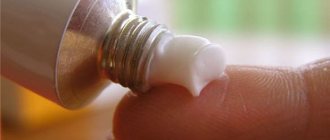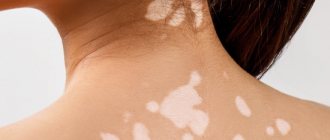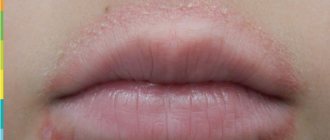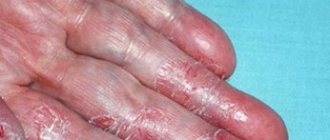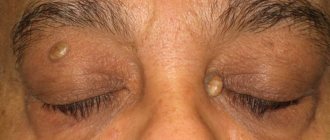What to do if a spot appears on the skin like a burn?
If you find a spot that looks like a burn, contact a cosmetologist or dermatologist. After examination, the specialist will determine the root causes of the formation of such a spot, as well as make a diagnosis and prescribe appropriate therapy.
All pigmentations on the human skin are divided into certain types:
- superficial;
- deep.
They also come in different sizes and shapes. To identify fungal diseases, a Wood's lamp is used. After determining the cause of pigmentation on the skin, a set of procedures to eliminate it is prescribed. In this case, attention is paid to the patient’s age and skin type.
The following methods for removing pigmentation have proven to be the most effective:
- salon manipulations;
- medications;
- cosmetic products;
- traditional methods of getting rid of unwanted spots on the body.
What do they look like?
If a red spot has formed on the body that does not bother you, you should not ignore it. You should always consult a doctor, because the causes can be serious - from diseases of the blood and cardiovascular system to infectious diseases, including chicken pox, measles, scarlet fever, and pink fever. In such cases, serious consequences cannot be avoided. Only a specialist can prescribe the necessary examination and make a correct diagnosis.
Often skin reactions in the form of red spots that itch. This is how allergies, psoriasis, eczema, neurodermatitis, and lichen manifest themselves. It is better not to scratch such places, as you can introduce infection into the wounds. Before you ask yourself how to treat a spot on the skin similar to a burn, you should understand that it is not a disease in itself. The reasons need to be sought deeper, in the body. Whether this is a reaction to toxic substances or a symptom of some disease will be determined by experts.
What to do if the spot that appears is itchy?
The formation of red spots on human skin is a fairly common symptom of various diseases. The reasons for its occurrence can be quite varied.
If a spot on the skin itches, a number of tests are performed, depending on the cause of the red spot that looks like a burn:
- visual characteristics of pigmentation;
- general blood analysis;
- blood test for immunoglobulins, hormonal spectrum;
- scraping from the damaged area;
- general urine analysis;
- cytological examination;
- histological conclusion.
Causes
Physiological factors
Burning usually occurs in people with sensitive skin, even in the absence of a pathological factor. An unpleasant symptom is provoked by wearing itchy clothing or things made of synthetic materials. Women may experience a burning sensation on their face after applying skincare or decorative cosmetics, even if these products do not cause allergies. A typical cause of tingling and burning sensations on the skin of the legs is fatigue after a long walk.
Burns
Most often, symptoms are caused by exposure to high temperature or solar radiation. Any burn is accompanied by a severe burning sensation of the skin, which begins even during the action of the damaging factor and lasts from several days to several weeks. The skin appears pink or bright red in color; with deeper lesions, blisters filled with clear or cloudy contents form.
A burning sensation constantly bothers a person. The symptom becomes more noticeable when touching the affected area, applying medicinal ointments and sprays. The discomfort is greatly aggravated if the burn area comes under warm or hot water (for example, when swimming). As healing progresses, the burning sensation subsides and is replaced by periodic tingling and itching of the skin.
Chemical and electrical burns are characterized by deep penetration of the damaging agent - right up to the hypodermis, muscles and underlying tissues. With such injuries, burning fades into the background, since the main complaint is unbearable pain in the area of the destroyed epidermis and dermis. Burning sensations in the skin occur immediately at the moment of injury, when massive tissue destruction has not yet occurred.
Burning skin
Allergy
Skin hypersensitivity reaction is the second most common cause of burning skin. The symptom is determined in predisposed people upon contact with allergens: plant pollen, cosmetics, animal hair, food. Allergic burning is combined with urticaria, itchy skin rashes in the form of papules and vesicles. Watery eyes, sneezing, and discharge of clear mucus from the nose are often associated.
A burning sensation can be one of the components of seasonal allergies (hay fever). Sometimes this symptom becomes a harbinger of an attack of bronchial asthma: in this case, unpleasant manifestations are localized in a limited area and are accompanied by the presence of red spots on the skin. Often, burning sensations accompany pseudo-allergies when taking histamine liberators (chocolate, citrus fruits, strawberries).
Contact dermatitis
Burning skin is typical of the acute erythematous form of contact dermatitis, provoked by exposure to an irritant. The patient experiences painful and burning sensations, tingling, itching in the affected area. The skin takes on a bright red tint. In the bullous version of the disease, the burning sensation is complemented by the formation of blisters filled with clear liquid. Insignificant severity of the symptom occurs in the chronic form of dermatitis.
Psoriasis
Moderate itching and burning of the skin develops with the exudative form of the disease, which is manifested by the formation of scales and pronounced weeping. A burning sensation in the affected areas is disturbing during exacerbation of psoriasis. Symptoms intensify when scratching damaged skin or bathing. As a rule, the exudative process is detected in those suffering from endocrine pathologies (diabetes mellitus, hypothyroidism).
Herpes
Painful symptoms with apparently intact skin are characteristic of herpes zoster. Patients complain that the skin constantly burns, in order to reduce discomfort, they want to scratch it. Unpleasant sensations arise suddenly, last 12-24 hours, then specific vesicular rashes form at this site. In this case, severe burning pain persists until recovery, and can bother a person for a long time after the rash disappears.
With herpes simplex, the burning sensation of the skin is not so intense. Symptoms develop simultaneously with the appearance of vesicles filled with clear exudate. Patients note itching and an unpleasant tingling sensation in the affected area. The pain is moderate, unlike shingles. The burning stops when the rash heals and disappears.
Skin infections
Burning is one of the main symptoms of bacterial (impetigo, erysipelas), viral (molluscum contagiosum, HPV) or fungal (dermatophytosis, rubromycosis) skin lesions. Taking into account the etiology of the disease, burning sensations are accompanied by various local symptoms: vesicular and pustular rashes, peeling, lichenification.
Senestopathies
Pathology is observed in mental disorders: Kandinsky-Clerambault syndrome, hysterical neurosis, bipolar psychosis. Patients feel an intense burning sensation, sometimes feeling as if the whole body is “burning.” To cope with painful symptoms, the patient constantly scratches the skin and tries to apply ice. In some cases, the burning is so intense that the person rushes around the room, screaming or moaning.
Complications of pharmacotherapy
A burning sensation of the skin occurs with drug-induced dermatitis. Unpleasant symptoms develop both when drugs are applied externally (ointments, gels) and when drugs are administered orally or parenterally. Areas of rash or weeping form on the skin, which are accompanied by an unpleasant burning sensation. With each subsequent use of allergenic drugs, the affected area increases.
Rare causes
- Congenital diseases
: Hartnup disease, porphyria. - Connective tissue damage
: scleroderma, systemic lupus erythematosus, Shulman's disease. - Vascular disorders
: rosacea, rosacea, obliterating atherosclerosis. - Malignant neoplasms
: squamous cell skin cancer, basal cell carcinoma, melanoma.
Possible causes of spots on the skin
There can be many reasons for the appearance of a spot similar to a burn, for example:
- allergy;
- stressful situations;
- unbalanced diet;
- hormonal changes;
- diseases of internal organs.
Depending on the location of the spot, we can talk about certain causes of pigmentation:
- Redness on the neck:
- Atopic dermatitis can cause severe itching and red patches. Often this disease is associated with problems of the gastrointestinal tract. To eliminate spots and itching, you need to diet and avoid certain foods.
- Experiences. The main reason for the appearance of spots on the neck is a stressful situation? — we can talk about the presence of vegetative-vascular dystonia. To remove pigmentation, you need a shower or a series of physical exercises to find internal balance.
- Allergies can catch a person at the most unexpected moment. At the same time, a number of factors can cause such a reaction in the body. After eliminating which the spots and itching go away.
- Spots on the hands: Infectious diseases of various etiologies.
- Disturbed diet.
- Emotional shock
- Scabies is caused by a specific subspecies of mite. In this case, the itching is more pronounced at night. Infection occurs through contact.
- Disturbances in the functioning of internal organs.
- Seborrheic dermatitis. The root cause of such stain formation is the proliferation of fungus. It gets worse in winter. In addition to itching and scarlet pigmentation, yellow scales are formed. The spots may spread in the groin area, on both legs, and different areas of the face. Treatment is selected by a dermatologist.
- Irritation. Often this reaction of the body occurs due to wearing tight clothes.
You might be interested! What does a syphilis rash look like and where does it appear?
Infectious diseases
Infectious spots can cause:
- Measles. In addition to spots in different areas of the body, it manifests itself as a cough, with a sharp increase in temperature. There may be some peeling.
- Rubella. A viral disease that is accompanied not only by a rash on the body, but also by enlarged lymph nodes. When infected with rubella, you feel a general malaise and an increase in body temperature to 38 degrees. In this case, spots may appear several days after infection. First, the facial area is affected, and after a while, the spots spread along the body. In another article on our website you can see a photo of rubella.
- Children's scarlet fever. It is characterized by the appearance of a rash throughout the body, which later begins to peel off. The causative agent of the disease is streptococcus. The spots appear first on the neck, and then move to the chest and back.
- Chicken pox. Caused by a virus that belongs to the herpes group. Spots appear all over the body and the temperature rises. Very often the rash is very itchy. Recovery occurs 10 days after infection. The best method of treatment is still brilliant green.
Allergy
If the body has been exposed to a certain irritant for some time, an allergic reaction may occur. Spots appear on the skin, which gradually begin to cause itching.
The main reasons for the appearance of stains of this nature:
- use of untested medications;
- introduction of new products into the diet;
- house dust;
- plant pollen;
- fungal spores;
- arthropod bites;
- insect fur;
- chemical cosmetic and cleaning components in the products used.
To eliminate an allergic reaction, you need to eliminate the allergen from your life.
Here you will find a similar article on the topic that these are red dots on the body like moles.
Dermatological diseases
Diseases of this nature have existed for many years. The appearance of red spots on the body, similar to a burn, already indicates the presence of problems with the skin of the body.
The main causes of stains:
- Psoriasis. In psoriasis, red patches form a crust on the skin and cause severe itching. The nature of this disease has not been fully revealed.
- Eczema. Itching appears in the area of the red spot, and other symptoms and discomfort may be present. The provoking factors of this disease are allergens, stress, pregnancy or diseases of the internal organs.
- Hemangioma. Initially, a small mole is formed, which later grows and becomes quite large in size.
- Pigmentation. The appearance of red spots may also be preceded by hormonal dysfunction in the body.
Autonomic dysfunction
Very often, during a stressful situation, red spots appear on the skin. The manifestation of such a symptom is very often preceded by disturbances in the tone of blood vessels and capillaries in the area where the spots appear.
The manifestation of autonomic dysfunction can be weakened by:
- cold and hot shower;
- rest or sleep;
- physical activity;
- medicinal sedatives.
The causes of this disease are often due to:
- lack of vitamins in the diet;
- damage to the body's cardiac system;
- diseases of internal organs;
- damage to the nervous system.
Possible diseases
The appearance of any kind of changes on the body is an unpleasant event. The desire to get rid of them as quickly as possible is quite understandable. But before you run to the pharmacy for medications, it is worth finding out the cause of their occurrence. Among the most likely causes of spots on the skin that resemble burns are the following:
- Herpes zoster is a disease caused by a virus. It affects the nervous system and is associated with colds. The spots with this type of herpes are small in size and red in color. For herpes zoster, it is recommended to take medications that block the development of the virus (antiviral), drugs that have high biological activity (steroids). In order to dry the stains, it is recommended to smear them with brilliant green. Taking the multivitamin drug Neuromultivit will consolidate the result of treatment.
- Urticaria is a disease characterized by the appearance of blisters on the skin, similar to the effects of a burn. The causes of urticaria are varied: taking medications or food additives, sudden temperature changes, infectious diseases. The disease is accompanied by difficulty breathing and burning.
- Pityriasis versicolor is an infectious disease caused by a fungus. It appears as red spots on the skin that look like a burn. They appear more often in spring and summer, as this is the time when the infectious agent is active and the amount of sunlight increases. Treatment should be comprehensive: the use of soap with antifungal substances, ointments, salicylic alcohol, a solution of which is used for rubbing.
- Atopic dermatitis is a chronic disease. The skin with this type of dermatitis is dry, the patient experiences itching in the area of the elbow and knee bends. The cause of the disease is considered to be various types of allergens. In treatment, steroid drugs, hormones, and antihistamines are used. To relieve dry skin and itching, it is recommended to use moisturizing creams and take baths adding medicinal oils. It is also worth following a diet and conducting phototherapy sessions.
- Allergic reaction - to identify the true cause, it is worth undergoing examination using high-tech devices. This will help to accurately determine the cause of the allergy and prescribe treatment.
- Stress can cause spots on the skin that look like a burn. They go away on their own and do not require outside intervention.
- Spots after burns. They will have to be treated for at least six months if you use a remedy such as Skinoren. When removing old stains, it is recommended to use sea buckthorn oil and aloe juice. You can also apply cucumber compresses.
Thus, spots on the skin that look like burns can occur for various reasons. Their appearance is an alarming signal from the body that should not be missed. It is better to immediately seek help from a doctor.
Treatment
The doctor can prescribe any preventive measures only after a comprehensive examination of his patient.
In this case it is necessary to determine:
- root causes of the disease;
- possible complications;
- optimal diagnosis.
After diagnosis, it will be necessary to undergo drug treatment, which may be based on the following means:
- Local ointments or creams;
- Antibiotics;
- Vitamin complex;
- Antihistamines;
- Sedative.
Baths based on:
- oak bark;
- birch leaves;
- herbal preparations.
Diagnostics
A specialist in the field of dermatology will determine the cause of the symptom; if necessary, doctors of other specialties will be involved in the examination. The dermatologist conducts a visual examination of the areas of the skin where the patient feels a burning sensation, after which he takes material for laboratory tests. Diagnostic search includes the following research methods:
- Dermatoscopy.
Under a microscope, the doctor examines the structures of the skin and identifies the initial stages of pathological changes. This is a simple and non-invasive method, which is indicated if the patient has a burning sensation in the area of new growths or suspiciously changed areas of the skin. - Luminescent diagnostics.
Inspection of the affected area using a Wood's paw allows you to quickly confirm ringworm, pityriasis versicolor, and erythrasma. The technique is used for rapid diagnosis of pseudomonas infection and acne. - Scraping examination.
The upper layer of the epidermis from the affected area is taken for microscopic examination. This method is informative in the diagnosis of fungal and bacterial infections. If a dermatologist needs to clarify the nature of the pathological process, a histological examination of a skin biopsy is prescribed. - Blood tests
. A clinical test is performed to detect signs of inflammatory or autoimmune diseases. An increase in eosinophils in the hemogram indicates the allergic nature of the burning sensation. To assess the activity of dermatological diseases, a biochemical analysis with acute phase indicators and a proteinogram is prescribed.
During the period of remission of allergic dermatoses, prick tests are recommended to determine provoking factors and select ASIT. If there is a burning sensation in the lower extremities in elderly patients, duplex scanning of the peripheral arteries and arteriography must be performed. If complaints of burning skin are combined with inappropriate behavior of the patient, a psychiatric examination is prescribed.
Dressing for skin burns
